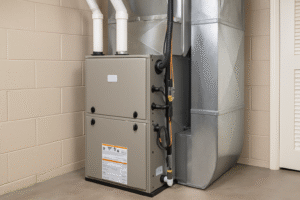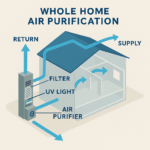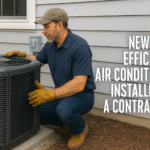The Best Furnace Setup for Comfort and Air Quality: Understanding Efficiency, Gas Valves, and Blower Motors
When it comes to heating your home, understanding what’s inside your furnace makes all the difference. After more than two decades running HVAC companies, one truth stands out — an educated customer is the best customer.
Choosing the right furnace isn’t just about brand or price; it’s about matching efficiency, gas valve design, and blower motor technology to your home’s unique comfort and air quality needs.
In this guide, we’ll break down what makes a furnace truly efficient, how gas valves affect comfort, and why modern blower motors are a game-changer for both airflow and energy savings.

TL;DR — What You’ll Learn
-
Efficiency ratings (80% vs. 90%+) come down to the design of the heat exchanger.
-
Gas valves determine how smoothly your furnace adjusts to temperature changes — modulating valves offer the best comfort.
-
Blower motors (PSC vs. ECM vs. variable speed) affect both energy use and indoor air quality.
-
Proper sizing is just as important as the equipment itself — bigger isn’t always better.
-
The ideal setup for most homes: a properly sized 97%+ modulating furnace with a variable-speed ECM motor.
Understanding Furnace Efficiency: 80% vs. 90%+
Furnace efficiency is defined by how well your system converts fuel into usable heat.
An 80% furnace vents 20% of its heat outdoors, while a 90%+ furnace reclaims more heat through a secondary heat exchanger. This second exchanger captures warmth from exhaust gases, pushing efficiency up to 96–97%.
However, there’s a catch — that same secondary exchanger can act like a filter. If your system uses a thin one-inch air filter, debris buildup can block airflow, effectively “insulating” the heat exchanger. As a result, your high-efficiency furnace may only perform like an 85% system.
Pro tip: Use a high-quality pleated filter and replace it regularly to maintain true high efficiency.
The Gas Valve: Where Comfort Meets Control
1. Single-Stage Gas Valve
This is the simplest — and least precise — type. It runs at full power all the time.
In Utah, furnaces are sized for extreme cold (5–12°F), but those conditions only happen a few hours a year. That means a single-stage system is oversized most of the time, causing temperature swings and uneven comfort.2. Two-Stage Gas Valve
A two-stage furnace adds flexibility by running on medium (≈60%) or high.
During most of the Utah winter, it runs on the lower stage — providing longer, gentler heating cycles and fewer hot/cold spots. Think of it like cruise control versus stop-and-go driving — smoother, more efficient operation.3. Modulating Gas Valve
The top tier is a modulating furnace, which can adjust its output in tiny increments — up to 70 “stages.”
No matter if it’s 5°F or 50°F outside, it delivers exactly the right amount of heat your home needs. The result: consistent comfort, even temperatures throughout the home, and higher overall efficiency.Why it matters: A modulating furnace virtually eliminates temperature stratification (where hot air rises and cold air sinks), keeping basements and upstairs rooms evenly heated.
Blower Motors: The Unsung Hero of Comfort and Airflow
Your blower motor pushes conditioned air throughout your home — and its design dramatically impacts energy use and comfort.
PSC Motors (Permanent Split Capacitor)
The old standard — AC motors that run at fixed speeds. These are noisy, inefficient, and costly to operate.
In fact, Utah’s energy assistance programs began replacing PSC motors years ago because they wasted so much power that the cost to run them outweighed replacement savings.ECM Motors (Electronically Commutated)
DC motors that use far less energy while delivering more airflow. They run cooler, last longer, and provide a noticeable boost in comfort.
They also reveal when your system is oversized, because ECMs move more air efficiently — often allowing smaller equipment to perform just as well.
A variable-speed blower maintains constant airflow, improving comfort and filtration. Variable-Speed Motors
These are advanced ECM motors that adjust automatically to maintain ideal airflow (CFM).
If your filter clogs or a vent closes, the motor compensates — ensuring your home still gets the right amount of air. This not only keeps temperatures stable but also protects air quality and filtration performance.Bonus: You can run a variable-speed blower on low continuously for air circulation — filtering, humidifying, and balancing your home’s temperature even when heating isn’t needed.
Why Furnace Sizing Matters More Than You Think
Even the best technology fails if your furnace is oversized.
Here’s why:At 5°F, you might need 80,000 BTUs to heat your home.
At 35°F, you only need 40,000 BTUs.
At 65°F, you need virtually zero BTUs, since your home and electronics naturally produce heat.If your first-stage gas valve is rated for 60,000 BTUs but your home only needs 40,000 most of the time, your system will short cycle — turning on and off frequently, wasting energy and wearing components prematurely.
Proper sizing ensures your furnace runs longer, steadier, and cleaner — which directly impacts both comfort and air quality.
The Top-of-the-Line Setup: What We Installed
For our great-grandfather’s 1,050-square-foot home, we chose:
-
97% efficiency furnace
-
Modulating gas valve (for fine-tuned comfort)
-
Variable-speed ECM motor (for constant air purification)
-
40,000 BTU downsizing (to perfectly match heating load)
The result?
-
Cleaner air thanks to continuous circulation.
-
Stable temperatures from basement to attic.
-
Energy savings all year round.
This replaced an outdated 80% single-stage furnace with a PSC motor — one of the least efficient setups possible. The difference in comfort and air quality was dramatic.
Key Takeaway
Modern furnaces aren’t just about heat — they’re about precision, efficiency, and healthy air.
A properly sized, high-efficiency furnace with a modulating gas valve and variable-speed ECM motor offers:
✅ Consistent comfort across every room
✅ Lower energy bills
✅ Cleaner, better-circulated airIf you’re upgrading your system, ask your installer about these components. Or, for expert recommendations tailored to your home’s climate and air quality needs, talk to our partners at At Your Service Pros.
References
-

